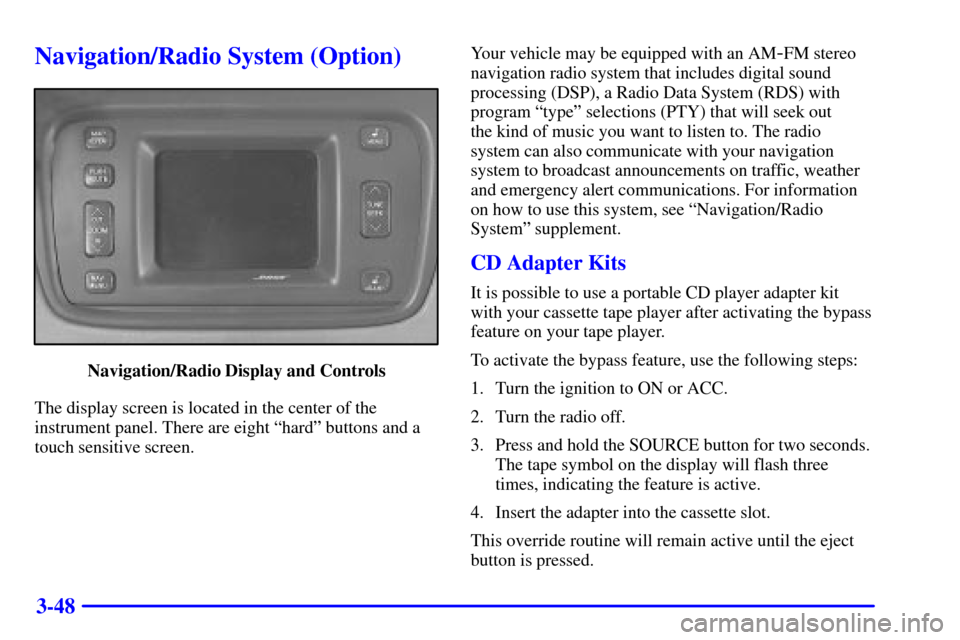Page 61 of 359

2-
2-1
Section 2 Features and Controls
Here you can learn about the many standard and optional features on your vehicle, and information on starting,
shifting and braking. Also explained are the instrument panel and the warning systems that tell you if everything is
working properly
-- and what to do if you have a problem.
2
-2 Keys
2
-4 Door Locks
2
-7 Remote Keyless Entry (RKE) System
2
-10 Trunk
2
-13 Theft
2
-14 Theft-Deterrent System
2
-16 PASS-Key� III
2
-18 New Vehicle ªBreak-Inº
2
-18 Ignition Positions
2
-19 Starting Your Engine
2
-21 Engine Coolant Heater (If Equipped)
2
-22 Automatic Transaxle Operation
2
-26 Parking Brake
2
-27 Shifting Into PARK (P)
2
-29 Shifting Out of PARK (P)
2
-30 Ultrasonic Rear Parking Assist
(URPA) (Option)
2
-31 Parking Over Things That Burn2
-32 Engine Exhaust
2
-32 Running Your Engine While You're Parked
2
-33 Windows
2
-34 Tilt Wheel
2
-36 Turn Signal/Multifunction Lever
2
-43 Exterior Lamps
2
-48 Interior Lamps
2
-50 Mirrors
2
-54 Storage Compartments
2
-57 Sun Visors
2
-59 Sunroof (Option)
2
-60 HomeLink� Transmitter (Option)
2
-64 The Instrument Panel -- Your
Information System
2
-69 Warning Lights, Gages and Indicators
2
-79 Driver Information Center (DIC)
2
-94 Navigation (Option)
Page 154 of 359
2-94
Navigation (Option)
Navigation Display and Controls
This display screen is located in the center of the
instrument panel. There are eight ªhardº buttons
and a touch sensitive screen.
Your vehicle may be equipped with a turn
-by-turn
navigation guidance system that includes a CD ROM
map media covering nine regional areas throughout
the contiguous United States. In addition, the system
includes intersection and freeway entrances, route
planning, a programmable address book, points of
interest, a list of restaurants, emergency phone
numbers, and a list of hotels and motels for all of
the major cities on each regional CD. The navigation
system can also communicate with the radio to
receive broadcast announcements on traffic, weather
information and emergency alert communications.
For information on how to use this system, see the
ªNavigationº supplement.
Page 155 of 359

3-
3-1
Section 3 Comfort Controls and Audio Systems
In this section, you'll find out how to operate the comfort control and audio systems offered with your vehicle.
Be sure to read about the particular systems supplied with your vehicle.
3
-2 Comfort Controls
3
-2 Climate Control Panel
3
-6 Air Conditioning
3
-6 Heating
3
-7 Defrosting and Defogging
3
-7 Rear Window Defogger
3
-8 Ventilation System
3
-10 HVAC Steering Wheel Controls
3
-10 Climate Control Personalization (If Equipped)
3
-11 Audio Systems
3
-11 Setting the Clock
3
-11 AM-FM Stereo with Cassette Tape and
Compact Disc Player
3
-16 AM-FM Stereo with Cassette Tape and
Compact Disc Player with Radio Data Systems
(RDS) and Digital Signal Processing (DSP)
(If Equipped)
3
-25 AM-FM Stereo with Cassette Tape and MiniDisc
Player with Radio Data Systems (RDS) and
Digital Signal Processing (DSP) (If Equipped)3
-34 AM-FM Stereo with Cassette Tape and
Radio Data Systems (RDS) with Digital
Signal Processing (DSP) and Communiport
�
Infotainment System (If Equipped)
3
-47 Radio Data Systems (RDS) Program
Type (PTY) Selections
3
-48 Navigation/Radio System (Option)
3
-48 CD Adapter Kits
3
-49 Console-Mounted CD Changer (Option)
3
-51 Radio Personalization with Home and Away
Feature (If Equipped)
3
-52 Theft-Deterrent Feature
3
-52 Audio Steering Wheel Controls
3
-53 Understanding Radio Reception
3
-53 Tips About Your Audio System
3
-54 Care of Your Cassette Tape Player
3
-55 Care of Your Compact Discs
3
-55 Care of Your Compact Disc Player
3
-56 Diversity Antenna System
Page 202 of 359

3-48
Navigation/Radio System (Option)
Navigation/Radio Display and Controls
The display screen is located in the center of the
instrument panel. There are eight ªhardº buttons and a
touch sensitive screen.Your vehicle may be equipped with an AM
-FM stereo
navigation radio system that includes digital sound
processing (DSP), a Radio Data System (RDS) with
program ªtypeº selections (PTY) that will seek out
the kind of music you want to listen to. The radio
system can also communicate with your navigation
system to broadcast announcements on traffic, weather
and emergency alert communications. For information
on how to use this system, see ªNavigation/Radio
Systemº supplement.
CD Adapter Kits
It is possible to use a portable CD player adapter kit
with your cassette tape player after activating the bypass
feature on your tape player.
To activate the bypass feature, use the following steps:
1. Turn the ignition to ON or ACC.
2. Turn the radio off.
3. Press and hold the SOURCE button for two seconds.
The tape symbol on the display will flash three
times, indicating the feature is active.
4. Insert the adapter into the cassette slot.
This override routine will remain active until the eject
button is pressed.
Page 342 of 359
6-66
Fuse Usage
6 Heated Seat Left Rear
7 Power Tilt and Telescoping Steering
8 Supplemental Inflation Restraint
9 Not Used
10 Lamps Park Right
11 Fuel Tank Ventilation Solenoid
12 Ignition 1
13 Lamps, Parking Left
14 Interior Lamp Dimmer Module
15 Navigation
16 Heated Seat Left Front
17 Export Lighting
18 Rear Door Modules
19 Stoplamps
20 Neutral Safety Back
-up
21 Audio
22 Retained Accessory Power for SunroofFuse Usage
23 Not Used
24 Not Used
25 Passenger Door Module
26 Fuel Door/Trunk Release (Body)
27 Interior Lamps
28 Rear HVAC Blower
29 Ignition Switch
30 Not Used
31 Heated Seat Right Front
32 Continuous Variable Road
Sensing Suspension
33 Heating, Ventilation, Air Conditioning
34 Ignition 3 Rear
35 Antilock Braking System
36 Turn Signal/Hazard
37 Heated Seat Right Rear
38 Dash Integration Module